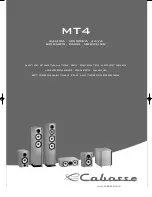
5
INSTALLATION
Perform the following steps to install this speaker.
1.
Determine the desired mounting location for the speaker.
2.
Using a 1/4" drill bit, drill a hole through the ceiling for the speaker/safety wire cable
bundle to pass through.
3.
Feed the cable through the hole in the ceiling.
4.
While supporting the speaker at the desired height, take out the slack from the
cable within the ceiling and secure the safety wire to a beam, truss, or other solid
support.
5.
Multiply the rated RMS power output of your amplifier by 0.8 to determine the
maximum total wattage for the speaker array.
Example: If you are using the 14886 120-watt PA amplifier, the maximum wattage of
the connected speaker array is 120 x 0.8 = 96 watts.
6.
Determine which transformer tap to use on this speaker. The following table
indicates the wattage values for each of the three taps in 70V and 100V systems.
Transformer Taps
Green
Yellow
Red
70V Array
1.85 watts
3.75 watts
7.5 watts
100V Array
3.75 watts
7.5 watts
15 watts
7.
Run speaker wire from the amplifier to the speaker installation location.
Important Safety Warning! You must use in-wall rated speaker wire for residential
installations or plenum rated speaker wire for commercial installations.
8.
Connect the positive lead of the speaker wire to the Green, Yellow, or Red lead on
the speaker, then connect the negative lead to the Blue lead on the speaker. Use
electrician's tape, wire nuts, or heat shrink tubing to protect and isolate the
electrical connections. Similarly, the unused taps should be have their exposed
conductors taped or otherwise protected from accidental contact.
Summary of Contents for 14890
Page 1: ......


























